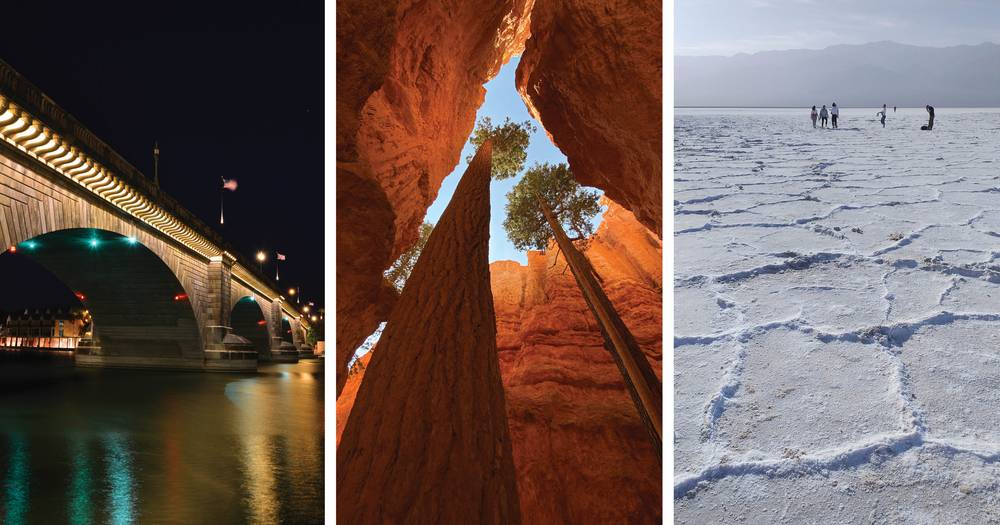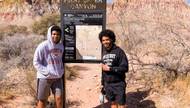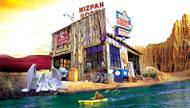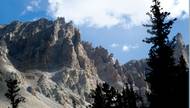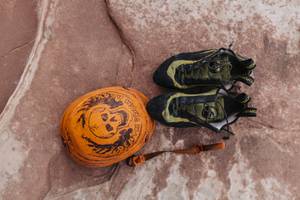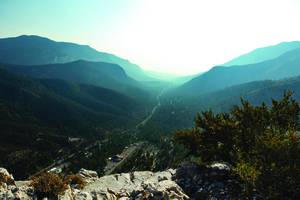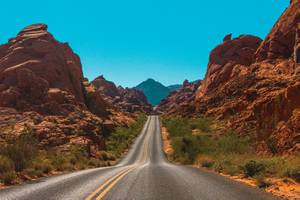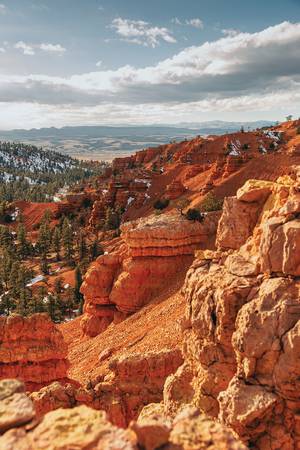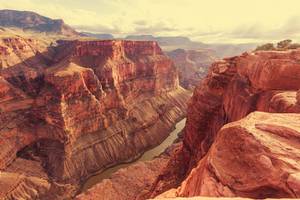Within One Hour
Distance from Las Vegas: 30 miles.
The largest reservoir in the United States, boasting 750 miles of shoreline, is our very own aquatic playground. Desert dwellers find year-round fun in the country’s largest national recreation area, where swimming, boating, hiking, camping and more await. Walk the Historic Railroad Trail for some of the most majestic views of the lake, then find yourself at Hoover Dam, an engineering marvel that never ceases to amaze.
Must-do: For a different view of Hoover Dam—from the water—book a kayak tour with Evolution Expeditions (evolutionexpeditions.com). A knowledgeable guide will take you from the base of the Hoover Dam down the Colorado River and through the Black Canyon.
Distance from Las Vegas: 40 miles.
If you think Nevada is all desert, think again. About a half an hour from the Strip sits this mountainous expanse, an oasis and reprieve from the scorching heat, complete with all the seasons. Whether you’re seeking snow in the winter or just a getaway from triple digits in the summer, Mount Charleston has a trail—or a campsite—for you.
Must-do: Ride the ski lift in the springtime, followed by lunch at the Mt. Charleston Lodge. If you’re there in the winter, try snowboarding, skiing and/or sledding.
Distance from Las Vegas: 18 miles.
With its colorful scarlet and orange palette, strolling through Red Rock feels more like walking on Mars, but don’t be fooled: You’re very much in Nevada. With hikes for every age and fitness level—plus some of the world’s best rock climbing—it’s no wonder this park is a destination for some of the most avid thrill-seekers.
Must-do: Calico Tanks or Ice Box Canyon for a moderate hike (or Turtlehead Peak if you want to really work up a sweat), followed by lunch at Cottonwood Station in the nearby town of Blue Diamond.
Distance from Las Vegas: 45 miles
Ghost towns are always fun places to explore, and there’s no shortage of them in Nevada. This one, an old mining town, is just a 45-minute drive from Las Vegas. It’s literally rich in history: In 1775, Spaniards discovered gold here and named the town Eldorado. The mines were active until 1945. Today, it’s full of rusted cars and various ruins of the past, including original buildings from its heyday.
Must-do: Take a tour down the gold mine, once the richest in Nevada, operating for 80 years until World War II.
Distance from Las Vegas: 55 miles
It’s one of the most memorable destinations in Southern Nevada, and before hikers and adventurers sought out its beauty, it was home to prehistoric peoples, whose petroglyphs are still visible on multiple trails, including Mouse’s Tank and Atlatl Rock. From the early Pueblo tribe to the Paiute, this red sandstone state park is full of history, ready for exploration.
Must-do: Stop at the visitor’s center to learn about the unique landscape and its history, then head to the Elephant Rock for a photo-op and Mouse’s Tank to scope out some cool archaeological finds.
ALSO: Amargosa Big Dune; Ash Meadows National Wildlife Refuge; Boulder City; Spring Mountain Ranch State Park.
Within Two Hours
Distance from Las Vegas: 122 miles.
This 100-mile stretch of Nevada State Route 375 runs adjacent to the Nevada Test and Training Range, which includes Area 51. Over the years, numerous UFO sightings have been reported in the area, and the government’s 2013 acknowledgment of the existence of Area 51 only added to the mystery. Note that Area 51 is an active military facility, and mind the warning signs.
Must-do: Your otherworldly trek must start with provisions at E.T. Fresh Jerky in Hiko and selfies at the alien murals. Since Area 51 itself is off-limits, stop by the Alien Research Center for a photo-op with a three-story metal alien, then drive to the town of Rachel and stop by the Little A’le’Inn for a burger and a beer.
Distance from Las Vegas: 152.7 miles.
With 300 days of sunshine, it’s (almost) always sunny in Lake Havasu, also known as “Arizona’s West Coast” and “Arizona’s Playground.” Watersports—boating, fishing, swimming or just hanging out at the beach—are the star of this Arizona vacation destination, and you can also hike, golf, cycle or go off-roading. Check out Topock Gorge, aka “the miniature Grand Canyon.” Don’t bother loading up your boat; you can rent one when you get there.
Must-do:See the London Bridge … yes, the historical one from Merry Olde England. The nearly 200-year-old structure crossed an ocean and traversed the Panama Canal to become an Arizona tourist attraction.
Distance from Las Vegas: 120 miles.
Just a few hours away from Las Vegas, this town with popular hiking and outdoor activities for groups and families awaits. A perfect stop on the way to Zion National Park, the 7,400-acre Snow Canyon State Park is home to old lava fields, rock climbing routes, bike paths and more.
Must-do: Bring the kids and grab a burger at Morty’s Cafe.
ALSO: Grand Canyon West; Kanarra Falls; Rhyolite Ghost Town; Zion National Park.
Within Three Hours
Distance from Las Vegas: 262 miles.
Bryce Canyon’s winter landscape is dramatically different from its summertime look. Freshly fallen snow caps the hoodoos as the evergreen trees rise majestically against the red rocks. The park is quieter, too, giving visitors time for reflection and contemplation. If you’re lucky enough to be there after a big snowfall, snowshoeing is a fun way to explore. For day hiking, wear proper footwear, preferably with traction devices, as paths will be icy.
Must-do: Ruby’s Inn Campground, located near the entrance of the canyon, has plenty of winter activities for the whole family, like outdoor ice skating, cross-country skiing, snowmobiling and sleigh rides. No need to bring your own equipment—you can rent everything for full-day use.
Distance from Las Vegas: 167 miles.
Cathedral Gorge, one of Nevada’s first four state parks, was founded in 1935, but its history dates back much further. Millions of years ago, volcanic activity set the stage for the park’s magnificent spires and cliffs by depositing volcanic ash. The area became a meadow and then a lake bed and then dried up again. All the while, water and wind erosion built up breathtaking landscape full of gorgeous slot canyons.
Must-do: Check out the historic 1930s water tower, then hike the mile-long Miller Point Trail for panoramic views.
Coral Pink Sand Dunes State Park
Distance from Las Vegas: 181 miles.
Just west of the town of Kanab, Utah, mountains of pink sand dot an otherworldly landscape, where you can play and frolic and roll down soft hills. The destination is popular for ATV riders and snowboarders, but the area’s so expansive, you’ll feel like you’re on an alien planet all by yourself.
Must-do: Just 20 minutes away is Best Friends Animal Society, the largest no-kill shelter in the country. It’s home to 1,600 rescued cats, dogs, horses, birds, rabbits, potbellied pigs, farm animals and assorted wildlife. You can volunteer to walk four-legged friends or eat a vegan lunch at the Angel Village Cafe. You might even go home with a new best friend.
Distance from Las Vegas: 150 miles.
It’s the hottest and driest national park in the United States, not to mention the lowest—the park’s Badwater Basin sits 282 feet below sea level. Explore giant, sprawling sand dunes; colorful ice cream-colored mountains; and imprints of mysterious sailing stones, if you happen upon them. (Don’t forget to bring plenty of water.)
Must-do: Check out the Mesquite Flat sand dunes or the 7-mile-long Panamint Dunes, then head to the Badwater Salt Flats and Zabriskie Point for a beautiful overlook.
Distance from Las Vegas: 180+ miles.
With land running through both the Colorado River and the Great Basin and spanning 170 miles across Utah, Dixie National Forest is home to hundreds of hiking trails in its four distinct geographic zones. Start in Cedar City and go as far as you’d like—the options are endless. Extreme temperatures are common in the forest, so come prepared, as the weather can range from triple digits in the summer to 30 degrees below in the winter at some of the forest’s highest peaks.
Must-do: Take the scenic byway on the All-American Road Highway 12. Be sure to pack a camera.
Vermillion Cliffs National Monument
Distance from Las Vegas: 235 miles.
Designated in 2000, this 280,000-acre national monument is as spectacular to see as it is difficult to visit. With no paved roads inside the monument, the scenic views and geologic formations typically require a four-wheel drive vehicle, ideally with high clearance and a spare tire in tow. But the unspoiled nature’s worth the effort—dramatic plateaus, cliffs, buttes and canyons. The BLM recommends opting for an authorized guide if you don’t feel completely confident braving the wilderness.
Must-do:Vermillion Cliffs is part of a captive breeding program for California condors, so this is a chance to spot the endangered birds.
ALSO: Cedar Breaks National Monument; Duck Creek Village; Grand Staircase-Escalante National Monument; Joshua Tree National Park; Panguitch Lake.
Within Four Hours
Glen Canyon National Recreation Area
Distance from Las Vegas: 257 miles.
Nearby Antelope Canyon remains closed, but this 1.25 million-acre area in Arizona remains open. You can hike, bike and camp; boat, fish and swim at Lake Powell; take a scenic drive along Hole-in-the-Rock Road; and view the Glen Canyon Dam and the Rainbow Bridge National Monument, a natural rock archway.
Must-do: Glen Canyon’s show stopping feature is Horseshoe Bend, where the Colorado River cuts a canyon to make a dramatic U-turn. Reach the overlook via a 1.5-mile (wheelchair-accessible) hike from a parking lot owned by the city of Page, Arizona.
Grand Canyon National Park (GrandCanyon.com, nps.gov/grca)
Distance from Las Vegas: 275 miles.
You can’t be a true Southwesterner if you haven’t visited the Grand Canyon at least once. First-timers should visit the South Rim for what GrandCanyon.com calls the “true Grand Canyon” experience, though the North Rim, which is closed for the winter, offers more chances to commune with nature without skimping on world-class views of the Colorado River.
Must-do: Take one of the COVID-safe virtual tours, including a virtual raft trip and Canyon Field School @Home, and then visit the South Rim in person for unforgettable vistas of the mile-deep canyon.
Distance from Las Vegas: 275 miles.
Sedona is a gateway to the Grand Canyon for most travelers, but this gorgeous, red rock-rich spot is a destination in its own right. It’s an understatement to call the vibe there chill. Sedona operates on its own frequency, and a daytrip there can truly change one’s perspective.
Must-do: Hiking is king, with more than 100 trails. The Cathedral Rock Trail is one of the most popular, offering unparalleled views of red rock formations, but also check out the Palatki Heritage Site, ancient cliff dwellings once home to the Hopi tribe.
ALSO: Berlin-Ichthyosaur State Park; Flagstaff, Arizona; Great Basin National Park; Jerome, Arizona; Prescott, Arizona.
Gear Up: Packing tips for your next daytrip
Even if you’ll be back in a few hours, you’ll want to make sure you have these in your car …
• Food and water. Due to COVID-19 conditions, you might not be stopping for a meal, so pack picnic provisions that can be easily eaten on the go. Think sandwiches, chips, cut-up veggies, hummus and treats. And above all, make sure you have enough water for everyone in the car. The temps might be cool, but you’ll be thirsty if you plan to do lots of hiking.
• Extra masks. Of course, the goal is to limit your stops, but you’ll still be pausing to gas up. It’s also never a bad idea to mask up even while hiking and walking around outside, especially in high-foot-traffic areas.
• Hiking shoes. Most of the destinations on our list offer plenty of hiking opportunities, so pack appropriate footwear.
• Small backpack. Use it to stash power bars and water bottles for your hike.
• Paper maps. No one carries around atlases these days, but it doesn’t hurt to print one out, in case you find yourself in a cellular dead zone.
• Extra phone charger. It’s always a good idea to make sure your phone is fully juiced, in case of an emergency.
• Camera. For shutterbugs who want more than the cameras on their smartphones can offer.
• Entertainment. Load up digital and analog distractions for the kids, so everyone has fun. It’s a great time to catch up on podcasts, so download a few to play in the car. –Genevie Durano
